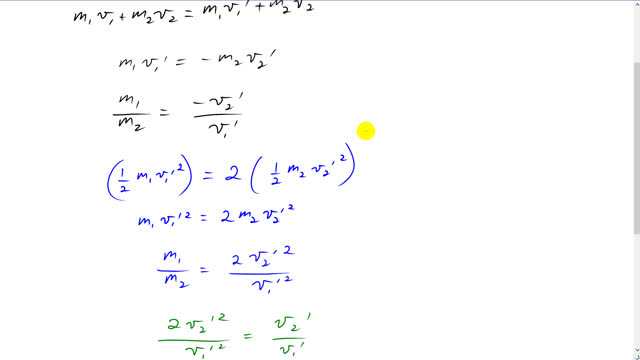
An object at rest is suddenly broken apart into two fragments by an explosion. One fragment acquires twice the kinetic energy of the other. What is the ratio of their masses?

In order to watch this solution you need to have a subscription.
This is Giancoli Answers with Mr. Dychko. We are going to find the ratio of the masses of these two fragments based on conservation of momentum first and then we'll figure out the ratio of masses based on knowing that the kinetic energy of one particle is twice the kinetic energy of the other particle and in both cases, we are just gonna get a formula that doesn't quite give us the ratio but then we can combine them and say that, well, m 1 over m 2 equals this and m 1 over m 2 equals that then this has to equal that which we say here— I'm gonna go through this slowly in a second by the way— and then find the ratio for the velocities and then equate that to the ratio of masses. So let's figure out how that was done. This is the textbook conservation of momentum formula and initially, these two fragments are combined into a single thing that has no velocity so those two terms are zero and then we'll move this term to the left side and then switch the sides around and then we get m 1v 1 prime equals negative m 2v 2 prime and then find the ratio of masses by dividing both sides by v 1 prime and we get m 1 over m 2 is negative v 2 prime over v 1 prime. We expected a negative sign there because we can see that the velocities are gonna be in opposite directions so the velocities are gonna have opposite signs but the ratio of masses should be a positive number— doesn't make any sense to have a ratio of mass which is negative. So this quotient will result in a positive number since we are gonna have one of these velocities being negative so negative of a negative making a positive. Anyway that's as far as we can go with conservation of momentum at this point so then we need to bring in this information that the kinetic energy of particle 1 is 2 times the kinetic energy of particle 2 and well there's one-half is a common factor we can cancel from both sides and we get m 1v 1 prime squared equals 2 times m 2v 2 prime squared and find the ratio of masses again, m 1 over m 2, and we'll divide both sides by v 1 prime squared and we are also dividing both sides by m 2 and we have m 1 over m 2 then is 2 times v 2 prime squared divided by v 1 prime squared. Now we know that m 1 over m 2 equals this thing here and m 1 over m 2, we have now discovered equals this so that means these two are equal to each other which I said here. So 2 times v 2 prime squared divided by v 1 prime squared equals v 2 prime over v 1 prime and you can divide both sides by v 2 prime and also divide both sides by 2 and multiply both sides by v 1 prime and then on the right-hand side, you are just left with the number one-half because this v 2 prime cancels with this one and the v 1 prime cancels there and these exponents are gone because dividing by those and multiplying by that so we are left with v 2 prime over v 1 prime equals one-half. Well, m 1 over m 2 is the negative of v 2 prime over v 1 prime so that negative sign's a bit of an issue isn't it so where did that come from? This kinetic energy formula doesn't care about direction because when you square the velocity, it's the same as taking the velocity's absolute value because you are multiplying a negative by a negative no matter what the velocity is, it's gonna be positive so we just have to understand that the ratio of masses has to be a positive number. So we'll say that it's equal to positive one-half; there, good enough.
why does m1v1+m2v2 equal to 0
Hi chitodavid12, initially the two fragments are joined together and they are not moving. Since they're not moving, their total initial momentum is zero.
Cheers,
Mr. Dychko
Thanks
Why is the negative sign from the v2 prime early not considered in the final calculation. Thanks.
Hi Ichbishop, thanks for the question. I suppose there's a bit of an oversight here, although it isn't a critical one since in the end we're looking for a ratio of masses, which we know must be positive. In the substitution shown in green, it would be slightly better to write in which case . Then the substitution into would lead to the negatives cancelling, resulting in the expected positive final answer. Thanks for noticing that detail.
All the best,
Mr. Dychko